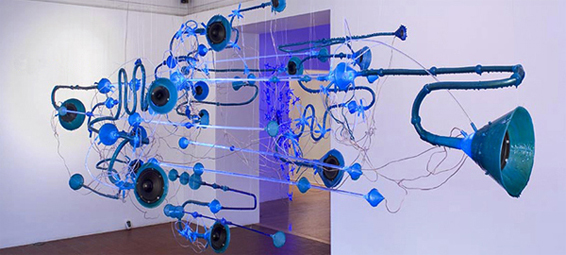Deborah Aschheim’s work explores memory as an imperative. In response to the threat of forgetting, it undertakes a general effort to remember. The title of this exhibition, the “method of loci,” is named for the ancient technique, described by scholars such as Frances Yates, of exploiting the capacity to remember spaces and places by mentally “placing” other information in those imagined places. One might memorize a list of people by imagining each of them in a particular location, then recalling the entire list by retracing a mental journey through each of those places. Here, the salience of place is expressed as a memory of 1960s-era architectural modernism at a moment when it is threatened by redevelopment. The majority of works, six ink drawings on Duralar transparent polyester film, and one wall-mounted Duralar construction, are based on a study of several Bertrand Goldberg buildings in Chicago. Goldberg was known for his use of circular forms in his plans, which were efficient and easily constructed in prestressed concrete.
Three of the drawings deal with the architect’s 1969-1975 Prentice Women’s Hospital, notable for having its exterior shell supported by cantilever from the building’s core, removing the need for interior support columns. Prentice is currently the object of an energetic preservation campaign (see Blair Kamin, Arch Daily, Landmarks Illinois). It is threatened by the major expansion plans of its owner, Northwestern University, which, like countless universities, is benefiting from the boom in higher education. Aschheim’s drawings Prentice deconstructed no. 1 (The harder I try to remember) and Prentice deconstructed no. 2 (Like trying to remember a person), both 2011, present overlapping views of the structure in disjunctive fragments, much the way memory-images appear in the mind. The Unrequited series of drawings, of which there are three here (all 2012), combine references to several Goldberg structures in Chicago, including the Prentice and the iconic Marina City mixed-use downtown towers (Arch Daily; Princeton book).
An earlier body of work, represented here by one sculpture, models the pathways and connections of memory. Different parts of the brain store different kinds of memory (for example, words vs. music). Annoying commercial jingles, or “earworms,” exploit this fact, burrowing a tune into listeners’ musical memory so that they will not forget the associated words. For her Earworm series of sculptures, Aschheim drew up a list of especially significant words to preserve in her memory, thinking ahead to her own advanced years and the threat of memory loss. Her collaborator Lisa Mezzacappa composed a piece of music for each word on the list. The music was incorporated into sculptures, one of which, Earworm (node), 2008, based on the word “node,” is on view here. It has the sense of the complex efficiency of a jet engine manifold, as speakers and sounds emerge from the ends of tubes, linked together and hanging in midair. In these works, memory is a consolation, but an ambiguous and partial one.
Image: Earworm (node), 2008





